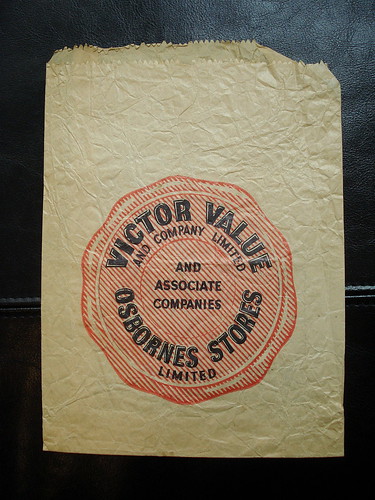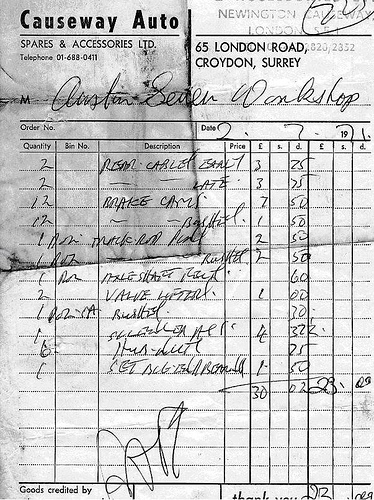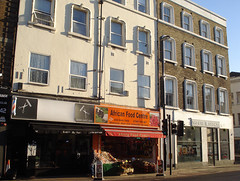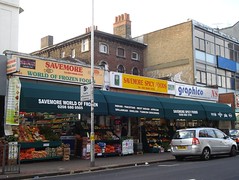Savemore World of Frozen Foods at 65 London Road is very closely connected with its neighbour, Savemore Spicy Foods at numbers 67–71. Together, these two shops provide fresh meat, frozen fish, a wide range of interesting vegetables, and African and Asian groceries to the shoppers of West Croydon.
1840s–1930s: Construction of the building, and its linked history with number 63
Despite this current connection to its neighbours at 67–71, the history of the building is much more closely bound up with its neighbour on the other side — number 63. As noted in my article on 63 London Road, numbers 63 and 65 started life between 1844 and 1851 as a single building that was later extended forwards on the ground floor and split into two shops.
1930s–1960s: Victor Value
The independent history of number 65 thus begins in the mid-1930s with the arrival of Victor Value, a family-run grocery chain originally founded at 1424 London Road in 1932 by William, Alexander, and Morris Cohen.[1] The branch at 65 London Road was in place by May 1935, at which point Victor Value had at least seven other branches in London and its surrounds.[2]
A photograph at Croydon Local Studies Library shows Victor Value at 65 London Road in the late 1940s as a small shopfront divided by a set-back door in the middle, with glass display windows to either side. Goods are stacked up in each window, and an advertisement for “Hornimans Dividend Tea” is prominent. Blocky capital letters above the windows spell out the name “VICTOR VALUE CO”.[3]
Like other supermarket chains, Victor Value moved towards self-service in the 1950s.[5] A planning application for “internal alterations” to create a “self service store” at 65 London Road was granted to “Messrs Victor Value & Co Ltd” on 31 August 1956, and the work was completed by August 1957.[6]
Writing in the Simply Whitstable Visitors Book, Martin Beale recalls Victor Value as “a well known chain in the 60s, though to me, it always appeared a bit tatty.”[7]
It was certainly a relatively substantial chain. Pile it High, Sell it Cheap, Maurice Corina’s authorised biography of Tesco head Jack Cohen (no relation to the Cohens of Victor Value),[8] describes Victor Value as “one of [Tesco’s] strongest rivals” in the 1960s.[9] A 2001 obituary of Alexander Cohen describes it as “[ranking] alongside Sainsbury’s and Fine Fare as one of the leading food chains in the south of the country, vying with Tesco for market leadership.”[10] Nor was it confined to the south of England; there were Victor Value branches throughout the UK in places including Cardiff[11] and Staffordshire.[12]
Victor Value also acquired a number of other firms over the years, including Goodworths and Swettenham’s.[14] One relatively late acquisition was Anthony Jackson’s Foodfare, which took place in December 1965. This is of particular interest because Foodfare was previously controlled by Sydney Ingram, nephew of Tesco’s Jack Cohen, and Sydney had in fact approached his uncle about a merger before choosing to accept the Victor Value offer.[15]
The Anthony Jackson acquisition, however, proved to be the beginning of the end for Victor Value. As with the earlier Swettenham’s takeover, Victor Value struggled to incorporate its new purchases into its organisation.[16] These organisational difficulties were paralleled by financial ones: Victor Value’s pre-tax profits in 1967 were a third of the 1965 figure,[17] its shares fell from 12s 6d to 8s 9d between November 1967 and January 1968,[18] and it declared no dividend for 1967.[19]
Sydney Ingram, perhaps now regretting his choice to sell his company to Victor Value, urged Tesco to put forward a takeover bid to rescue the latter.[20] An initial meeting between Hyman Kreitman of Tesco and Neville Cohen of Victor Value took place in a roadside layby, but this somewhat cloak-and-dagger approach was swiftly followed by a day-long meeting between directors of both companies which ended with Tesco bidding £8.5million for full control of Victor Value.[21]
The takeover was complete by mid-1968, and Victor Value’s 217 branches became part of Tesco, bringing the latter’s count to 834 branches.[22] It’s unclear whether the store at 65 London Road was ever rebranded to Tesco, but in any case it was gone by July 1971, after more than three decades at the premises.[23]
Early 1970s: Causeway Autos
Following Victor Value’s departure, planning permission was granted in July 1969 for new signage for a car parts company: Causeway Autos. This was a branch of a family-run company, Northwood Spares & Accessories Ltd, based on Newington Causeway near Elephant & Castle.[24]
The company was founded by 1920 as H Northwood & Son, motor car specialists, and had a presence at 45 Newington Causeway by 1950. In March 1958 it opened an additional branch at 34–36 Newington Causeway, “linked by intercommunication by 12 Relay Sets from [the] main store”.[25]
By 1968, the family were running 34–36 Newington Causeway under the name of Causeway Auto Spares & Accessories Ltd.[26] This was under the special charge of Harry Northwood, oldest of the five siblings involved in the business at this time, and was well known as a supplier of parts for the classic Austin Seven car. Dave P, an Austin Seven enthusiast, recalls:[27]
Harry will be fondly remembered by older Austin Seven owners as one of the original and major suppliers of Austin Seven parts, and he also delighted in dealing in surplus and ex W.D. [War Department] stuff. Causeway Autos was a treasure trove of eclectic motoring items and out the back of the shop where I was allowed access, stock was piled from floor to ceiling.
Hugh Barnes adds:[28]
I can remember it being stacked floor to ceiling with stuff and, when I hesitantly asked if they had Austin 7 stuff, the guy who I spoke to visibly perked up and led me through to a back room full of it!
While the above quotations refer to the original Causeway Autos shop on Newington Causeway, by mid-1971 the family also had branches at 65 London Road, Croydon, and at 89 High Street, West Wickham. The West Wickham branch survived until at least 1984, but the Croydon branch was very short-lived, and had gone again by early 1973.[29]
Mid-1970s: Associated Safe Co
The replacement for Causeway Autos was the Associated Safe Co, which moved to London Road from its previous address at 196 Brighton Road, South Croydon, between early 1972 and early 1973. It remained here for a couple of years before moving to Hackbridge.[30]
1970s–1990s: Croydon Angling Centre
The Associated Safe Co was gone by early 1976, and by January 1979 the Croydon Angling Centre had arrived to take its place.[31] This was run by John McCarthy, a keen fisherman who represented England in angling competitions. The shop remained on London Road for two decades, finally closing in 1999.[32]
2000s: Savemore Afro Cosmetics
By May 2000, the Croydon Angling Centre had been replaced by Savemore Afro Cosmetics, an offshoot of next-door’s Savemore Spicy Foods. However, by July 2007 business was slow enough that the owners had made the decision to leave the world of cosmetics and use number 65 to extend their grocery shop.[33]
2007–present: Savemore World of Frozen Foods
Nearly eight years later, number 65 continues as part of Savemore, though the dividing wall between here and 67–71 still remains. This side of the shop is long and narrow, and the front is dominated by the butchers counter that runs along one wall. Shelves opposite display African groceries, and freezers further back are stocked with frozen fish. Employees stand behind the butchers counter, ready to prepare the meat in any way you choose — and once it’s packaged up, you’re given a payment slip to take to the till at the front.[34]
Thanks to: Khalid at Savemore; John McCarthy; Graham Foster; James Ingram; Neil Tyler, for providing advice on researching Victor Value; Leigh Sparks, for providing advice, materials, and feedback regarding Victor Value; the Austin Seven enthusiasts (Bryan Norfolk, Dave P, David of the Devon Sevens, David Waller, Hugh Barnes, Jeff Taylor, Jon, squeak, Steve Jones, and The Management of the Austin Sevens Friends forum); the Planning Technical Support Team at Croydon Council; all at the Croydon Local Studies Library; and my beta-readers Flash and Henry. Census data and London phone books consulted via Ancestry.co.uk.
Footnotes and references
- According to a notice in The Times of 26 June 1946 (copy provided by Leigh Sparks), Victor Value & Co was “founded in 1932 by Messrs. William, Alexander and Morris Cohen”. The earliest appearance of Victor Value in London phone books is in November 1932: “Value & Co, Victor, Genl Storekeepers” at 1424 London Road, SW16.
- Victor Value appears at 65 London Road in London phone books from May 1935 onwards. Note that in May 1935 the branch at 65 London Road is under “Victor” and all other branches are under “Value”; this discrepancy is fixed in the subsequent edition, with all branches appearing under “Value”. In addition to the two London Road branches, the May 1935 phone book lists shops at 74 Streatham High Road SW16, 77 Sydenham Road SE26, 75 Westow Hill SE19, 541 Garratt Lane SW18, 41 Thornton Heath High Street, 196 Rye Lane SE15, and 22 The Promenade N3.
- Photo ref PH/96 2702; the date comes from the handwritten note “Late 1940’s” on the back. This is the image used in Effie Fotaki’s “Capturing Croydon” photo, reproduced here.
- Date of the older photo is taken from the original print at Croydon Local Studies, which has “Late 1940’s” written on the back.
- See my article on 9–11 London Road for more on the general switch to self-service.
- Planning application ref 56-1003, viewed on microfiche at Croydon Council offices.
- It’s not clear whether Martin’s comment about tattiness applies to Victor Value in general or to the Canterbury branch specifically; he goes on to say “There was one in Canterbury (St George’s Street) but that was the only one I can clearly recall.” (Unfortunately as of mid-2019 the Simply Whitstable Visitors Book has been offline for a while, and I seem to have neglected to archive it.)
- Not only is Cohen a very common surname, but also Jack Cohen’s surname at birth was actually spelled “Kohen” (see Oxford Dictionary of National Biography; subscription required, but if you’re a member of Croydon Libraries you can sign in with your library card number).
- Chapter 11, p171. Leigh Sparks, Professor of Retail Studies at the University of Stirling, points out that “Tesco itself was very southern at this time”, so this doesn’t necessarily mean that either chain was particularly well-known outside London and the South-East (personal communication, 24 February 2015).
Alexander Cohen’s obituary appears in The Times of 22 January 2001. Article accessed on ProQuest UK Newsstand (requires login, but a Croydon Libraries library card number will do).
Note that although this obituary states that Alexander Cohen “inherited the business from his father, Victor, a successful toy importer”, I haven’t been able to find any independent evidence of a Victor Cohen ever having been involved in Victor Value. The “Victor” in the name of the company might suggest the involvement of a person called Victor. However, this person could well have been the Iion Victor Cummings listed in the abovementioned notice in The Times of 26 June 1946 as the chairman of London Grocers, the wholesale company associated with the Victor Value retail chain. (“Iion” is a very unusual name, but this spelling is confirmed by a listing in the England & Wales FreeBMD Birth Index, 1837-1915.)
Moreover, this notice suggests that Alexander’s father’s name was in fact William; it states that London Grocers was “incorporated in England on the 15th December, 1937, as a Private Company under the name of W. Cohen & Sons Limited for the purpose of acting as wholesalers in conjunction with the retail grocery business trading as Victor Value & Co [...which itself...] was founded in 1932 by Messrs. William, Alexander and Morris Cohen”.
- An article in Wales Online, 23 April 2014, mentions a branch of Victor Value on the corner of Inverness Place and Albany Road in Cardiff. According to OpenStreetMap, as of December 2014 this is a Tesco Metro (see main article on sale of Victor Value to Tesco).
- An article by retail consultant Graham Soult makes mention of a Victor Value store in the Gungate Precinct (now demolished) in Tamworth. A letter from Roy Finney in The Sentinel, 23 March 2013, describes Victor Value as “Stoke’s first supermarket”, on the corner of Campbell Place and Hartshill Road previously occupied by a pub called The Grapes (letter accessed on ProQuest UK Newsstand via Croydon Libraries subscription as above). See also earlier footnote regarding Swettenham’s.
- Note the second name on the bag — “Osbornes Stores”. I haven’t been able to find out anything about this second company or its connection to Victor Value, aside from the fact that a liquidator with the address of Tesco head office (Tesco House, Delamere Road, Cheshunt) was appointed for both companies on 11 July 1973 (London Gazette, 23 July 1973, p8639).
- Information on Goodworths and Swettenham’s comes from the 2001 Alexander Cohen obituary. I haven’t found much information on Goodworths, but Swettenham’s was based in Chesterton, Staffordshire, according to an article in the Stoke-on-Trent newspaper The Sentinel, 5 September 2009 (accessed on ProQuest UK Newsstand via Croydon Libraries subscription as above). The Swettenham’s takeover seems to have occurred around 1960. Pile it High, Sell it Cheap states that it happened around the same time as Tesco took over Irwins (Chapter 11, p172) and that the Irwins takeover happened in September 1960 (Chapter 10, p150). Similarly, Counter Revolution states that it happened “some months” after a 1960 discussion of a merger between Tesco and Victor Value (Chapter 8, pp 121–122; see this reference for more details of this merger discussion, which in the end came to nothing).
- Date of Foodfare takeover and information about Sydney Ingram and his approach to Jack Cohen comes from Pile it High, Sell it Cheap (Chapter 10, p169). This source spells Mr Ingram’s name as “Sidney” rather than “Sydney”, but Sydney’s grandson James Ingram tells me that it was actually spelled “Sydney” (via email, 7 July 2021), and several articles found via the British Newspaper Archive (for example, one on page 2 of the 20 December 1965 Daily Mirror) confirm this. According to a letter in The Grocer, the sales director of Anthony Jackson’s, Reg Morgan, went on to become managing director of Victor Value.
- Counter Revolution describes the situation thus: “Largely a family-run business, and managed on what could best be described as highly idiosyncratic lines, Anthony Jackson’s proved too much for Victor Value to digest” (Chapter 8, p122), while Pile it High, Sell it Cheap states that “The general opinion was that neither the Swettenhams nor the Anthony Jackson take-over [sic] was a great success, and that Victor Value lacked the management flexibility to weld the new businesses into its organization.” (Chapter 11, p172). Counter Revolution also describes several other organisational difficulties faced by Victor Value, including “shrinkage” (internal theft) allegedly perpetrated by individuals from Cohen family members through senior directors down to individual shop managers (Chapter 8, p124).
- Counter Revolution states that Victor Value’s pre-tax profits fell from £664,998 in 1965 to £232,351 in 1967 (Chapter 8, p122); these figures also appear in Pile it High, Sell it Cheap (Chapter 11, p172).
- Share prices taken from Pile it High, Sell it Cheap (Chapter 11, p172).
- Lack of 1967 dividend taken from Counter Revolution (Chapter 8, p122).
- Pile it High, Sell it Cheap, Chapter 11, p173.
- The layby meeting and the decisive day-long meeting are described in both Pile it High, Sell it Cheap (Chapter 11, p173) and Counter Revolution (Chapter 8, p123). The figure of £8.5million is given as an exact one in Counter Revolution (Chapter 8, p123) and as “around £8,500,000” in Pile it High, Sell it Cheap (Chapter 11, p174).
- Date of Tesco takeover, number of Victor Value branches, and number of Tesco branches after the takeover are all taken from Counter Revolution (Chapter 8, p123). The figure of 217 branches is also mentioned in Tiger by the Tail, the biography of former Tesco Chairman Ian MacLaurin, which states that “the Victor Value Takeover [...] added 217 stores to the Tesco chain” (Chapter 1, p19).
Victor Value is listed at 65 London Road in phone books from the May 1935 London (L-Z) edition to the April 1968 Outer London: North East Surrey edition, inclusive. It is absent from the September 1969 edition, though several other Victor Value branches are listed. The July 1971 North East Surrey edition lists Causeway Autos at 65 London Road. Regarding a possible rebranding, the list of Tesco stores in the September 1969 phone book is very similar to that in the April 1968 edition, and does not include 65 London Road.
The small size of the properly is one likely reason for Tesco selling the property on after acquiring it from Victor Value. An article published in The Times shortly before the takeover (10 April 1967, p15, copy provided by Leigh Sparks) quotes Hyman Kreitman as saying: “I don’t want to get involved with superettes, which are really anything under 5,000 sq. ft. Investment in refrigeration alone is uneconomic on such a small scale, when we want to display a really wide range of meat and cheese.” Measuring on Google Maps aerial view shows that the ground floor of 65 London Road is only around 1,600 square feet.
- The planning application granted in July 1969 was for “an illuminated sign” for Causeway Autos, 65 London Road (ref A5383, viewed on microfiche at Croydon Council offices). Another planning application, by Northwood Spares and Accessories Limited, 64–66 Newington Causeway, SE1, for another sign “for Causeway Autos, 65 London Road” was refused in 19 September 1969 as it “would be unduly prominent and seriously detrimental to the visual amenities of the general street scene by reason of its excessive depth and illumination.” (ref A5463). Although this application was refused, it does establish a link between Northwood’s on Newington Causeway and Causeway Autos in Croydon.
- H Northwood & Son is listed at 17 Rockingham Street SE1 in the April 1920 London phone book with the phone number of HOP 2820. It is absent from the previous edition (July 1919), though it’s of course possible that the company existed then but wasn’t on the phone. Later in the 1920s (October 1922 to April 1925 at least) it’s listed at 15 Rockingham Street SE1 and 75 Cranham Road SE16. The October 1950 edition lists Northwood Spares & Accessories Ltd at 45 Newington Causeway with phone numbers including the original HOP 2820. Information on the branch that opened in March 1958 is taken from the January 1959 Northwood’s Austin Seven catalogue as quoted by squeak on the Austin Seven Friends forum.
- The documentary evidence for this is somewhat contradictory, as listings in contemporary London phone books seem to jump around between different addresses. Northwood is listed at 45 Newington Causeway until October 1967, and at number 64 in April 1969. Causeway appears for the first time in May 1968, listed at number 45; in March 1970 it’s instead at number 34. However, Dave P states on the Austin Seven Friends forum that “Causeway Autos and Northwoods were situated on opposite sides of Newington Causeway and were owned by the Northwood family.” and confirms in another posting that “Nos.34/36 Newington Causeway was the Causeway Autos shop.” David Waller of the Austin Seven Owners Club (London) tells me that Causeway Autos in Newington was an existing shop that was taken over by Northwood’s, and that “I think they [Northwood’s] took on the stock from Causeway and when they ran out of A7 parts I and other owners then moved on to other dedicated A7 spares suppliers.” (via email, 29 December 2014)
- Dave P’s words are taken from a reply to my question on the Austin Seven Friends forum, 29 December 2014. This reply is also the source of my information on Harry and his siblings. David Waller corroborates Dave’s judgment, telling me that “Causeway Autos was THE place to go for A7 parts in the ’60s for southern owners” (via email, 28 December 2014).
- Hugh’s words are taken from another reply on the Austin Seven Friends forum, 30 December 2014.
Regarding the Croydon branch, Causeway Auto Spare [sic] & Accessories Ltd is listed at 65 London Road in the July 1971 Outer London: North East Surrey and the February 1972 Croydon phone book. The March 1973 Croydon phone book instead lists the Associated Safe Co Ltd. Regarding the West Wickham branch, “Northwood (Kent) Spares & Accessories Ltd, Mtrs” is listed at 89 High Street, West Wickham, in the Outer London: North West Kent phone book from September 1971 to September 1984 inclusive. (I don’t have access to North West Kent phone books beyond 1984.)
Dave P states on the Austin Seven Friends forum that “I believe the Croydon shop was Harry’s pet project, as he lived somewhere out that way in Surrey or Kent.” Dave later corrects this, as he was actually thinking of the West Wickham branch, but it does seem likely that Harry was also the brains behind the Croydon expansion.
- Croydon phone books list the Associated Safe Co at 196 Brighton Road in February 1972 and 65 London Road in March 1973 and July 1974. The August 1974 Goad plan shows “Associated Safe Co safes & locks”. The February 1975 Outer London: North East Surrey phone book also lists the company at 65 London Road, along with another similarly-named company: Associated Security Alarms Ltd. The January 1976 Croydon phone book instead lists both of these companies at 59 London Road, Hackbridge, along with Associated Lock Services Ltd.
- As noted above, the January 1976 Croydon phone book gives a Hackbridge address for the Associated Safe Co. The Croydon Angling Centre is absent from the July 1977 Croydon phone book and the November 1978 Bromley & Orpington phone book, but is listed at 65 London Road in Croydon phone books from January 1979 onwards. It’s also shown on Goad plans from March 1983 to May 1997 inclusive, initially with “John McCarthy & Keith Gash” in brackets, from March 1985 to June 1992 with “John McCarthy” alone, and from April 1993 onwards with no associated names. It also appears on a photo at Croydon Local Studies Library with the notation “2/97” (i.e. February 1997); this photo has no apparent ID number, but it’s in the section for 141.4 London Road.
- Information on John McCarthy’s fishing for England is taken from the Bury Hill Fisheries website. Bury Hill gave me John’s phone number, and he confirmed that he was the John McCarthy who ran the Croydon Angling Centre, and that the shop closed in 1999; unfortunately, he couldn’t spare the time to talk at greater length (phone call, 13 February 2015).
- Goad plans show Savemore Afro Cosmetics from May 2000 to May 2006 inclusive, and Savemore World of Frozen Foods from July 2007 to May 2011 inclusive. This name was on the frontage when I moved to West Croydon in mid-2011, and it’s still there today. Khalid at Savemore told me that the reason for the change was lack of business (conversation in shop, 18 February 2015).
- Information on Savemore World of Frozen Foods as it is today comes from personal observation.



